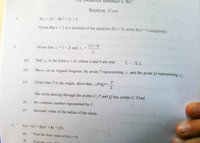You are using an out of date browser. It may not display this or other websites correctly.
You should upgrade or use an alternative browser.
You should upgrade or use an alternative browser.
Finding centre of circle on an Argand diagram, given 3 points
- Thread starter H.Bisho18
- Start date
pka
Elite Member
- Joined
- Jan 29, 2005
- Messages
- 11,986
Any three non-colinear points determine a circle. Here you have \(\displaystyle (0,0),~(3,2)~\&~(2,-3)\)the 3 points are. Origin, 3+2i, 2-3i. I was thinking i have to do something with 'mod' z-(a+bi) 'mod' = radius but then part e is find out the radius so now i'm confused.
Look at this link. You should learn to use that resource.
Any three non-colinear points determine a circle. Here you have \(\displaystyle (0,0),~(3,2)~\&~(2,-3)\)
Look at this link. You should learn to use that resource.
Cool, however without using that resource how would i find the centre?
pka
Elite Member
- Joined
- Jan 29, 2005
- Messages
- 11,986
Well, it is tedious in the extreme.cool, however without using that resource how would i find the centre?
Let \(\displaystyle \mathit{O} : (0,0),~\mathit{A} : (3,2)~\&~\mathit{B} : (2,-3)\)
Write the perpendicular bisector of \(\displaystyle \overline{\mathit{O}\mathit{A}}\) and the perpendicular bisector of \(\displaystyle \overline{\mathit{O}\mathit{B}}\).
Those two lines intersect at the centre of the circle call it \(\displaystyle \mathrm{C}\)
Now the length of \(\displaystyle \overline{\mathrm{C}\mathit{A}}\) is the radius.
Dr.Peterson
Elite Member
- Joined
- Nov 12, 2017
- Messages
- 16,749
This is much easier to solve geometrically. They told you to draw the diagram; that will at least suggest (and you can then demonstrate) that this is a right isosceles triangle (part of this is what you were told to prove in part c). You may know something about the circumcircle of any right triangle (that is, where the center of a circle is, that passes through the vertices); if not, you could add in a fourth point to form a square, and think about where its center is.
This is a good example of the fact that algebra is not always the best way to solve a problem, and that taking the time to think about a problem from multiple perspectives can help in finding the least tedious way.
In this case, just doing exactly what they say leads to this easy method! Textbook authors are not always trying to make things hard for you ...
This is a good example of the fact that algebra is not always the best way to solve a problem, and that taking the time to think about a problem from multiple perspectives can help in finding the least tedious way.
In this case, just doing exactly what they say leads to this easy method! Textbook authors are not always trying to make things hard for you ...


